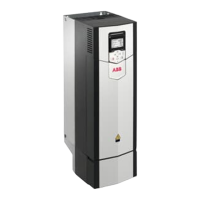group 94 LSU control. A regenerative supply unit will also send actual signals to
the inverter unit which are visible in parameter group 1 Actual values.
Settings and diagnostics
Parameters: 1.102 Line current (page 138)…1.164 LSU nominal power, 5.111 Line
converter temperature…5.121 MCB closing counter, 6.36 LSU Status Word…6.43
LSU CW user bit 3 selection, 6.116 LSU drive status word 1…6.118 LSU start inhibit
status word, 7.106 LSU loading package name…7.107 LSU loading package version,
30.101 LSU limit word 1…30.149 LSU maximum power limit, 31.120 LSU earth
fault…31.121 LSU supply phase loss, 95.20 HW options word 1 (page 513) and 96.108
LSU control board boot (page 526).
Parameter groups: 60 DDCS communication (page 405), 61 D2D and DDCS transmit
data (page 423), 62 D2D and DDCS receive data (page 430) and 94 LSU
control (page 504).
Events: 7580 INU-LSU comm loss (page 568), 7584 LSU charge failed (page 568),
AF80 INU-LSU comm loss (page 588) and AF85 Line side unit warning (page 588).
Motor control
■
Direct torque control (DTC)
The motor control of the ACS880 is based on direct torque control (DTC), the ABB
premium motor control platform. The switching of the output semiconductors is
controlled to achieve the required stator flux and motor torque. The reference
value for the torque controller comes from the speed controller, DC voltage
controller or directly from an external torque reference source.
Motor control requires measurement of the DC voltage and two motor phase
currents. Stator flux is calculated by integrating the motor voltage in vector space.
Motor torque is calculated as a cross product of the stator flux and the rotor
current. By utilizing the identified motor model, the stator flux estimate is
improved. Actual motor shaft speed is not needed for the motor control.
The main difference between traditional control and DTC is that torque control
operates on the same time level as the power switch control. There is no separate
voltage and frequency controlled PWM modulator; the output stage switching is
wholly based on the electromagnetic state of the motor.
The best motor control accuracy is achieved by activating a separate motor
identification run (ID run).
See also section Scalar motor control (page 88).
Settings and diagnostics
Parameters: 99.4 Motor control mode (page 536) and 99.13 ID run
requested (page 539).
Program features 77

